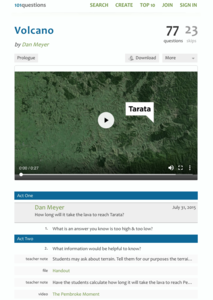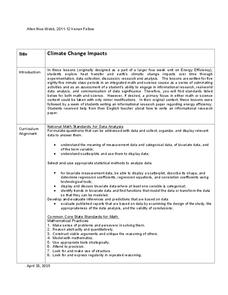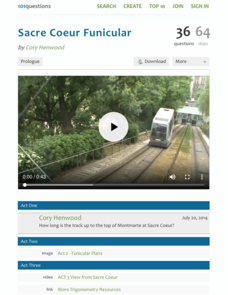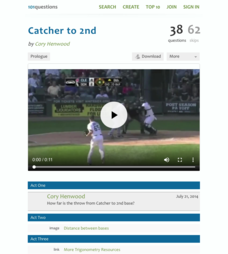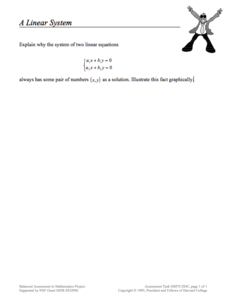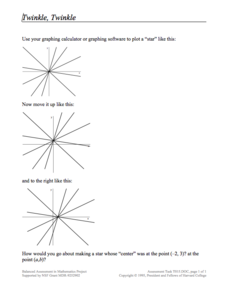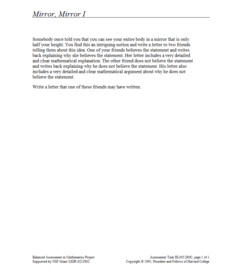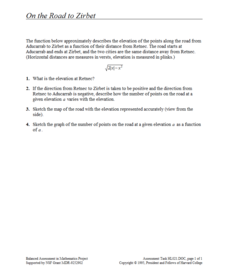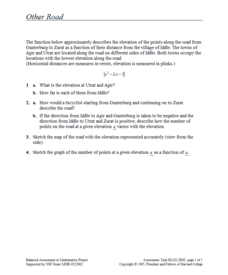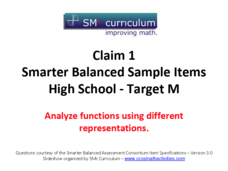101 Questions
Volcano
This resource will blow your mind! Young mathematicians estimate the rate of volcanic lava flow by watching a video. They apply the rate formula to determine how long it would take the lava to reach a city. Let's hope everyone gets out...
Fluence Learning
Construct Viable Arguments About Adding Fractions
Test mathematicians' knowledge of adding fractions with a brief assessment that challenges them to play teacher while correcting a peer's work. Scholars examine Carl's mathematical response, identify where he went wrong,...
101 Questions
Taco Cart
Sometimes you just need a taco. Young mathematicians investigate two different paths on a beach to get to a taco cart. Completion of the task requires finding distances using the Pythagorean Theorem and considering the different walking...
101 Questions
Bubble Wrap
Let your lesson pop by using the resource. After watching a video of a man popping a square piece of bubble wrap, young mathematicians determine the time it would take to pop other pieces of bubble wrap with given dimensions. The...
101 Questions
Gas Station Ripoff
Ever wonder if you can trust the pump that pumps your gas? Budding mathematicians use video evidence to analyze the cost-per-gallon ratio at different intervals for three different pumps. Their goal is to identify the pump that is...
Kenan Fellows
Climate Change Impacts
Turn up the heat! Young mathematicians develop models to represent different climates and collect temperature data. They analyze the data with regression and residual applications. Using that information, they make conclusions about...
101 Questions
Sacre Coeur Funicular
Rise to the challenge of trigonometry. Watching a video of an ascending funicular at the Sacre Coeur in Paris sets the stage for a challenging task. Young mathematicians use a given diagram, along with the concepts of slope and...
101 Questions
Catcher to 2nd
Who's on second? Young mathematicians use a diagram of a baseball field to find the distance a catcher must throw to reach second base. A brief video of such a play during a baseball game sets the stage for the assignment.
Concord Consortium
A Linear System
Young mathematicians have the hang of graphing with integer coefficients now. Can they generalize what they've learned to equations with variable coefficients? The task asks individuals to verify the solution to the system is (x,y) and...
Concord Consortium
Twinkle, Twinkle
Take a look at a star resource. Young mathematicians use a graphing calculator to draw intersecting lines that look like a star. They then apply translations to move the entire star and also consider what transformations must occur to...
Concord Consortium
Yearbook Pictures
Sorting memories doesn't have to be difficult. Young mathematicians evaluate two different methods of sorting yearbook pictures. They answer a set of questions to explore each method, then develop their own sorting procedure based on...
Concord Consortium
You Are What You Drive
Grab the wheel in learning about functions. A short performance task challenges young mathematicians to develop a function that describes the cars eight people drive. They consider whether the inverse of the function exists. If not, they...
Concord Consortium
Walled-Up Parabolas
Jump at the chance to use parabolas. Young mathematicians apply trigonometry to explore the trajectory of a ball in different situations. Some walls cause the ball to bounce, so participants must consider all possibilities.
Concord Consortium
Calculator Numbers
Know thy calculator. Young mathematicians use their calculators to answer a set of questions. They consider how the number of digits the calculator displays affects the answers to calculations. They then find examples of computations...
Concord Consortium
Catching Up
Class members have some catching up to do. Given a linear equation describing the distance of a runner, young mathematicians interpret the equation in terms of the context. They consider a general equation of the same form and describe...
Concord Consortium
Crossing the Axis
Mathematicians typically reference eight different types of functions. Scholars learn about the requirements for graphing a function and must decide how many different functions fit. To finish, they define each specific function meeting...
Concord Consortium
Defining Logarithms
An inverse relationship exists between exponents and logarithms, allowing mathematicians to easily convert one to the other. Scholars apply a brief definition of logarithms with a few practice problems. Then, they discover the...
Concord Consortium
Flying High
Some planes are just more efficient than others. Young mathematicians use data on the number of seats, airborne speed, flight length, fuel consumption, and operating cost for airplanes to analyze their efficiency. They select and use...
Concord Consortium
Losing Track
Don't lose the chance to use the task. Given three diagrams of curved pieces of wires, young mathematicians must explain whether it's possible to conclusively match the wires as representing cubic, exponential, or quadratic functions....
Concord Consortium
Mirror, Mirror I
How do you see yourself? Young mathematicians consider whether it's possible to view their whole bodies in a mirror with a length that is half their height. They write a letter to a friend explaining their positions mathematically.
Concord Consortium
On the Road to Zirbet
The road to a greater knowledge of functions lies in the informative resource. Young mathematicians first graph a square root function in a short performance task. They then use given descriptions of towns and the key features of the...
Concord Consortium
Other Road
Take the road to a greater knowledge of functions. Young mathematicians graph an absolute value function representing a road connecting several towns. Given a description, they identify the locations of the towns on the graph.
CCSS Math Activities
Smarter Balanced Sample Items: High School Math – Target M
Your knowledge of graphs is a function of how much you try. Young mathematicians work on a set of 12 questions that covers graphing functions, comparing functions, and rewriting functions in different forms to determine key features....
CCSS Math Activities
Smarter Balanced Sample Items: High School Math – Target O
Trigger an increased understanding of trigonometry. Young mathematicians answer a set of questions that require finding trigonometric ratios using similarity and solving real-world problems involving trigonometry. The questions all come...
Other popular searches
- Famous Mathematicians
- Great Mathematicians
- 5 Great Mathematicians
- Female Mathematicians
- Projects on Mathematicians
- Five Great Mathematicians
- The Great Mathematicians
- Mathematicians Fibonacci
- List of Great Mathematicians
- Hall of Great Mathematicians
- Whorls Famous Mathematicians
- The Old Grete Mathematicians
